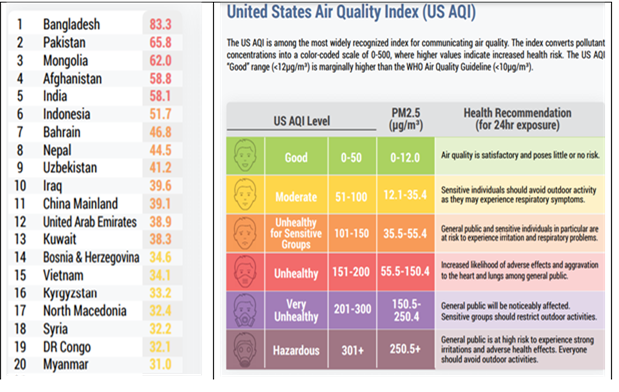IELTS Academic Writing Task 1 Sample 9
The list and the illustration show the world’s most polluted countries in 2019, and the risk faced by citizens as per the United States Air Quality Index (US AQI) bands. According to the US AQI, the data is based only upon PM2.5 (fine particulate matter) information which is collected from ground-based air quality monitoring stations. Describe briefly based on your understanding. (At least 150 words).
Additional information:
PM2.5 is defined as ambient airborne particles measuring up to 2.5 microns in size.
According to the WHO, not more than an annual mean exposure threshold of 10µg/m³ will help minimize the risk of health impacts from PM2.5.

Data Source: https://www.iqair.com/us/world-most-polluted-countries
-
Sample Answer |
|---|
The list of the top twenty of the world’s most polluted countries for the year 2019 has been taken from the annual list of the United States Air Quality Index (US AQI). Bangladesh has been ranked first, with an average PM2.5 level of 83.3, which falls in the category of “unhealthy” as per the AQI bands. At this level, its citizens are at an aggravated risk of contracting several diseases associated with the heart and lungs among other side effects. Pakistan, Mongolia, Afghanistan and India are among the top five most polluted countries with the PM2.5 level at “unhealthy” band at more than 55.5. As a combination, the Indian subcontinent emerges as the world’s most polluted zone. Indonesia, ranked sixth, is the first country in the category of “unhealthy for sensitive groups” with a PM2.5 level of 51.7. According to US AQI, the repercussions for this band is that the people in these countries will suffer from general respiratory discomfort and other kinds of irritation during long term exposure. Also, some groups who are more sensitive, may experience increased health consequences. Countries ranked between sixth to thirteenth fall in this category and include Bahrain, Nepal, Uzbekistan, Iraq, Mainland China, the UAE and Kuwait as per rank. The rest of the seven countries have a PM2.5 level between 12.1 to 35.4 and are classified as moderately polluted. At number fourteen is Bosnia & Herzegovina with 34.6 followed by Vietnam at 34.1. Kyrgyzstan, North Macedonia, Syria, DR Congo, and Myanmar complete the list with a PM2.5 level of at least 31.0. All these countries are far above the WHO recommended PM2.5 level of less than 10, and need urgent remedies to bring it down. |
-
Analysis |
|---|
COHERENCE AND COHESION
|
GRAMMAR
|
LEXICAL RESOURCE
|